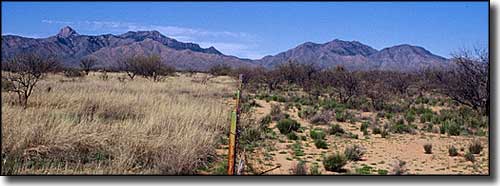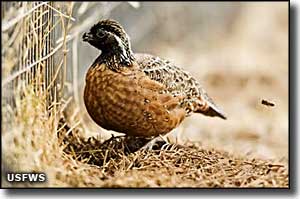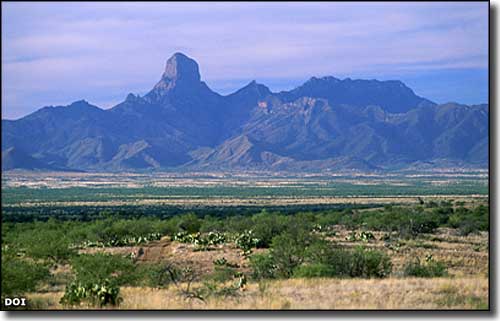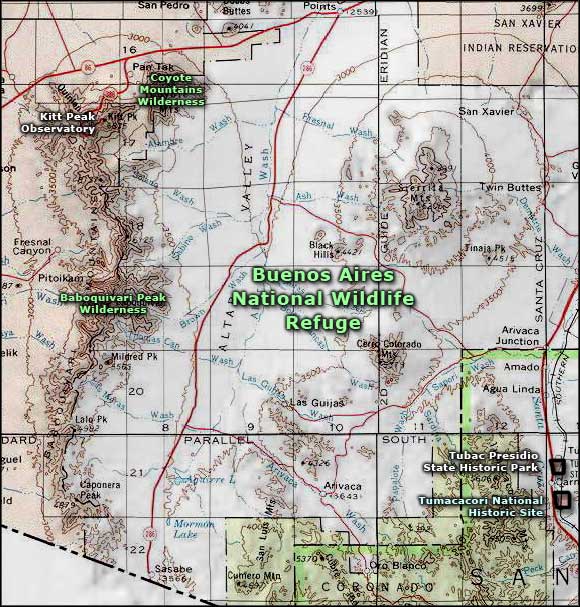
Buenos Aires National Wildlife Refuge

Cattle ranch on the right, Buenos Aires NWR (with no cattle) on the left

Buenos Aires National Wildlife Refuge (117,354 acres) in the Altar Valley of southern Arizona is a mix of wetlands, grasslands, sycamore and live oak mountain canyons and cottonwood-lined streambeds in the mountainous desert area southwest of Tucson near the Mexican border. The various habitats here are used by 7 endangered species, 10 species of serious concern and hundreds of other native plant and wildlife species. More than 320 species of birds alone have been recorded at Buenos Aires in a typical year. You'll find coyote, mule deer, pronghorn, javelina, coatimundi, mountain lion, ring-tailed cats and badger on the property. For reptiles there's desert tortoise and Gila monster, plus a couple varieties of rattlesnake.
Of special interest to the folks at Buenos Aires NWR is the recovery of the masked bobwhite quail. The last wild population of masked bobwhite quail is found in northern Mexico, about 150 miles south of Buenos Aires NWR. Refuge workers are working wih the ranchers in Mexico to restore that habitat to its former glory and to re-establish a U.S.-based breeding population of the species.
Some hiking trails are only accessible from the area of Arivaca: the Arivaca Creek Trail is 2 miles west of town (1 mile in length along a seasonal stream beneath the cottonwoods) and the Arivaca Cienega Trail is 1/4 mile east of town (1.25-mile loop over a boardwalk and path in a desert swamp/wetland). Access to the Brown Canyon Environmental Education Center (in a sycamore-lined canyon with willows and cottonwoods) is by appointment only (and you don't want to be either too early or too late as they will make arrangements to meet you on the side of the road). Brown Canyon is in the foothills of the Baboquivari Mountains. Branching off the Arivaca Creek Trail is the Mustang Trail, a 5-mile loop that climbs a rugged mountain named El Cerro with some steep sections near the top. There are also some old roads in the northeast and southeast grasslands of the refuge that make for good hiking and backpacking. Just south of the headquarters area on the entrance road is where you'll find Pronghorn Drive, a 10-mile loop through some of the open grasslands on the refuge with some great views over the Altar Valley. There are nearly 100 marked, primitive campsites on the refuge. The stay limit is 14 days. Fires are permitted in established fire rings at designated sites, but that may be restricted during times of high fire danger.
From the intersection of Highway 86 and Highway 286 near Robles Junction/Three Points, go south on Highway 286 for about 38 miles (to mile post 7.5). The refuge is on both sides of the road but you might want to go east from there and follow the signs to the Refuge headquarters. While the refuge is open 24 hours a day, the Visitor Center is only open from 7:30 am to 4 pm every day, except it is closed weekends between June 1 and August 15, and Christmas, Thanksgiving and New Year's Day.
Buenos Aires Ranch was one of the most successful livestock operations in southern Arizona until the property was bought by the U.S. Fish & Wildlife Service in 1985. That's when the Buenos Aires National Wildlife Refuge was born.

Baboquivari Peak to the west of Buenos Aires NWR

Buenos Aires National Wildlife Refuge area map
